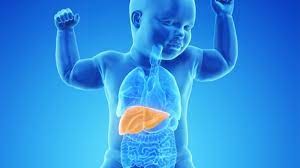
Serious diseases of children and newborns are a nightmare for parents. Many of these diseases are diagnosed late and can lead to serious consequences. However, God has gifted children with miraculous powers of recovery after any medical and surgical intervention, if done timely. Parents, nursing staff and doctors together can create miracles even when there was no hope.
In simple terms, liver and bile duct problems in children can be divided into structural problems or functional problems. The most common structural problems often requiring surgical correction are Biliary Atresia( bile ducts are not formed) and choledochal cyst( bile duct is dilated). There are many other diseases but they are rare.
Biliary Atresia
In simple terms it means that bile ducts have not formed. Bile is produced in liver and is transported to the intestine by bile duct. When this is not formed or malformed, bile is retained in the liver and leads to jaundice and liver damage.
Treatment: If done timely by an expert pediatric surgeon/hepatobiliary surgeon, surgery can correct the malformation by joining a part of the gut to the liver. About half of the cases are resolved by this initial surgery. Unfortunately, due the inherent nature of the disease, surgery fails in about half of the children. After initial surgery fails, Liver transplantation is the best option. This provides long term success and kids can lead a normal life. However, long term care and follow up is a responsibility which has to be taken seriously. Some of these children may give up taking their medications when they reach teenage and may end up loosing the transplanted liver.
Liver donor (usually mother/father/grandparent) remains healthy and the liver regrows to normal size both in donor and the child. Further pregnancies in eligible female donors are possible and life returns to normal within 1-2 months. In children, only a small portion of the liver is required for transplant.
Timing of surgery and transplant: Surgery should be done within 10 weeks or sometimes within 3 months. Failure of surgery is evident within 2-4 weeks of surgery and it is at that time that liver transplant is taken up. The intervening time may be used to prepare the donor, finances and other legal work.
Direct liver transplant without initial surgery is also an option especially if patients present late and liver cirrhosis(complete liver damage) has set in, or the structural defects are not curable by surgery. Long term success rates are excellent with liver transplant with more than 80% children being long term survivors. Given that the disease is nearly fatal without transplant, these are excellent results.
Bile duct cysts
When the tube connecting the liver and gut is dilated it appears as a cyst. Commonly these problems present when child is beyond 8-9 years of change or sometimes in young adults. Usually, children may have repeated fever, jaundice(yellow eyes), or a lump in the belly. Surgery is the mainstay of the treatment depending upon which type of dilatation it is. Sometimes these cysts occur in multiple places within the liver. For this variety(rare), liver transplantation is the most suitable option and long term survival is excellent. However, for most cysts, timely surgery by a pediatric surgeon/hepatobiliary surgeon leads to a normal life. Cyst is completely excised and gut is joined to the remaining bile duct.
Functional disorders of the Liver
These include what in medical terms is known as “metabolic disorders” of the liver. Fundamentally, there is a genetic disorder in which an essential enzyme is not made in the liver. This leads to many complications and gradually the child may suffer in multiple ways including growth retardation, skin changes, jaundice and multiple other symptoms. Some examples are Wilson’s disease, urea cycle disorders, familial hypercholesteremia.
The treatment for many of these diseases is li

ver transplantation as the new normal liver will provide the enzyme essential for survival of the child. As with most surgeries for children , the long term survival is excellent and the child leads a normal life if regular follow up and medications are maintained.
It must be remembered that timing is everything in pediatric liver diseases. If the treatment is started on time, even the sickest of children recover. Don’t be late or hesitant in seeking treatment for your child. Remember; we are in it, to win it!!
Dr Ashish K Mishra
MBBS, DNB(Surgical Gastro), FASTS: Fellow of the American Society of Transplant Surgeons (Liver and Kidney transplant)
University of Pennsylvania, Philadelphia, USA, Childrens Hospital of Philadelphia, USA.
Clinical Lead, Liver Transplant and Hepatopancreaticobiliary(HPB) Surgery Apollomedics Hospital, Lucknow, UP, India.
lucknowlivertransplant@gmail.com





